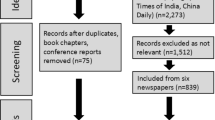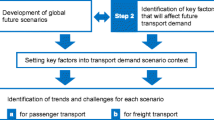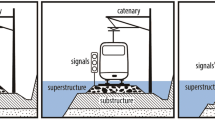Abstract
The past 15 years has been characterized by a high density of record-breaking weather extremes in Europe. These include the extratropical cyclones Lothar, Kyrill and Xynthia across western and mid Europe; the major floods in the UK, Germany and eastern Europe; the heat waves in 2003 and 2007 and, after a long period of mild winters, the heavy winter seasons in 2009/2010 and 2010/2011. Inspired by the rising trends in weather-related damages worldwide and the studies on the topic carried out in overseas, the EC funded the sister projects such as Weather Extremes-Assessing the Impacts on Transport and Hazards for European Regions (WEATHER), EWENT and ECCONET to determine the magnitude of current and future risks to the European transport sector and to assess suitable adaptation strategies. This paper presents the assessment framework of the WEATHER project and the results of weather-inflicted damage costs now and in 2040–2050. Total annual damages are found to be around €2.5 billion, which largely attribute to road traffic. However, broken down to passenger and ton kilometers the highest risk is borne by rail traffic due to its expensive infrastructures and its comparably complex operating structure. This indication even amplifies when looking four decades ahead: while average road transport costs will only raise by 7 % due to milder winters, rail traffic costs may increase by up to 80 % due to more floods and less predictable winter periods. A comparison with the results of the EWENT study uncovers a high range of uncertainty concerning methodological approaches and data treatment. Thus, the final figures might even be much higher.


Similar content being viewed by others
Notes
Converted with the exchange rate of 10/10/2012 of 1.608 US $/GBP.
References
Allen MR (2009) Attributing extreme weather events: implications for liability. In: Munich RE (2011) Liability for climate change? Experts’ view on a potential emerging risk. Munich, pp 2–5
Bijleveld F, Churchill T (2009) The influence of weather conditions on road safety. An assessment of the effect of precipitation and temperature. SWOV Institute for Road Traffic Safety, Leidschendam
Bos JMJ (2001) Door weer en wind, Gevolgen van perioden met extreem weer voor de verkeersveiligheid, Stichting Wetenschappelijk Onderzoek Verkeersveiligheid SWOV, R-2001-23, Leidschendam
Dobney K, Baker CJ, Quin AD, Chapmann L (2009) Quantifying the effects of high summer temperatures due to climate change on buckling and rail related delays in south-east Kingdom. Meteorol Appl 16(2):245–251
Doll C, Klug S, Köhler J, Partzsch I, Enei R, Pelikan V, Sedlacek N, Maurer H, Rudzikaite L, Papanikolaou A, Mitsakis V (2011) Adaptation strategies in the transport sector. WEATHER Deliverable 4. EC FP7. Fraunhofer ISI, Karlsruhe
Doll C, Schofer J, Durango-Cohen PL, Chhetri P, Kuhn K, Maibach M, Karagyozov K (2012) Special report: contributions from the international panel. WEATHER—Weather Extremes, Impacts on European Transport Systems and Hazards for European Regions. EC FP7. Project coordination. Fraunhofer ISI, Karlsruhe
DOT (2002) The potential impacts of climate change on transportation. Federal research partnership workshop October 1–2, 2002 summary and discussion papers. DOT Center for Climate Change and Environmental Forecasting
ECA&D (2011) European climate assessment & dataset. Online database: http://eca.knmi.nl/. Accessed 2011
Enei R, Doll C, Klug S et al (2011) Vulnerability of transport systems. Deliverable D1, WEATHER—Weather Extremes, Impacts on European Transport Systems and Hazards for European Regions. EC FP7. Project coordination. Fraunhofer ISI, Karlsruhe
ESSL (2011) Annual report 2011. European Severe Storms Laboratory (ESSL), Wessling, Germany
EUROCONTROL (2011a) Challenges of growth—environmental update study. Climate adaptation case-studies. EUROCONTROL Commentary, Brussels
EUROCONTROL (2011b) Onesky online flight database (access restricted). Online at https://extranet.eurocontrol.int/http://onesky1.eurocontrol.int/amserver/UI/Login?gw=extranet.eurocontrol.int&org=eurocontrol
EUROCONTROL, FAA (2009) US/Europe comparison of ATM-related operational performance. FAA Air Traffic Organization Strategy and Performance Business Unit, EUROCONTROL, Performance Review Unit, Washington DC, Brussels
Fiorello D, Akkermans L, Krail M, Schade B, Schade W, Shepherd S (2012) Results of the technoeconomic analysis of the R&D and transport policy packages for the time horizons 2020 and 2050. Deliverable D4.1, GHG-TransPoRD, EC FP7. TRT Trasporti e Territorio SRL, Milan, Italy
Gardiner L, Firestone D, Osborne A, Kouvelis B, Clark A, Tait A (2008) Climate change effects on the land transport network volume two: approach to risk management, NWH New Zealand Ltd. and National Institute for Water and Atmospheric Research. NZ Transport Agency Research Report 378, Wellington
Guha-Sapir D, Vos F, Below R (2012) Annual disaster statistical review 2011—the numbers and trends. Centre for Research on the Epidemiology of Disasters (CRED), Institute of Health and Society (IRSS), Université catholique de Louvain, Brussels
Hermans E, Wets G, Van den Bossche F (2005) Describing the evolution in the number of highway deaths by a decomposition in exposure, accident risk and fatal risk. Diepenbeek, Belgium
Howell L (ed) (2013) Global Risks 2013, 8th edn. World Economic Forum, Geneva
ICAO (2009) MET strategy in supporting the global ATM operational concept for the EUR region (working draft), neuilly-sur-seine. International Civil Aviation Organisation (ICAO), European and North Atlantic Office, France
IPCC (2007) Climate change 2007—synthesis report. Intergovernmental Panel on Climate Change (IPCC), Geneva
Knapp KK, Smithson LD, Khattak AJ (2000) The mobility and safety impacts of winter storm events in a freeway environment, mid-continent transportation symposium 2000 proceedings. Iowa, USA
Lemmen DS, Warren FJ (2004) Climate change impacts and adaptation: a Canadian perspective, natural resources Canada, Transport Canada, Ottawa
Leviäkangas P, Tuominen A, Molarius R et al (2010) Review on extreme weather impacts on transport systems. Deliverable D1. EWENT—Extreme Weather impacts on European Networks of Transport. EC FP7. Project coordination: VTT, partners: FMI, DLR, via Donau, CYMET, ESSL and TOI. Helsinki
Maze TH, Crum MR, Burchett G (2005) An investigation of user costs and benefits of winter road closures, MTC project 2003–2001. US Department of Transportation Research and Special Programs Administration, Washington
Munich RE (2010) Liability for climate change? Experts Views on a Potential Emerging Risk. Münchner Rückversicherungsgesellschaft, Munich
Munich RE (2011) TOPICS GEO. Natural catastrophes 2010—analyses, assessments, positions. Münchner Rückversicherungsgesellschaft, Munich
Munich RE (2012) Severe weather in North America. Perils—risks—insurance, executive summary. Knowledge series natural hazards. Münchner Rückversicherungsgesellschaft, Munich
Muzira S, Humphreys M, Pohl W (2010) Geohazard management in the transport sector, Transport Note No. TRN-40 March 2010. The World Bank, Washington, DC
Nokkala M, Leviäkangas P, Oiva K (2012) The costs of extreme weather for the European transport system. EWENT delliverable 4. Project funded under the Eroepan commission's FP7. Co-ordination, VTT, Espoo
Nolte R, Kamburow C, Rupp J (2011) ARISCC—Adaptation of railway infrastructure to climate change. Final report (6th draft version). Study Commissioned by the International Union of Railways (UIC). IZT—Institute for Futures Studies and Technology Assessment, Berlin
Perry AH, Symons LJ (1991) Highway meteorology. University of Wales, Swansea, Wales
PIARC (2010) Snow and ice data yearbook 2010, B5 winter service. World Road Association (PIARC) Technical Committee
Przyluski V, Hallegatte S, Romozeiu R et al (2011) Weather trends and economy-wide impacts. Deliverable 1, WEATHER. EC FP7. Fraunhofer ISI, Karlsruhe
Qiu N (2007) Effects of adverse weather on traffic crashes: systematic review and meta-analysis, 87th transportation research board (TRB) annual meeting. University of Iowa
Quan C, Trani AA, Srinivas S (2002) Modeling the economic impact of adverse weather into en route flights. Transp Res Rec 1788:76–82
RECORDIT (2003) Real cost reduction of door-to-door intermodal transport - deliverable 3 resource cost calculation for selected corridors. Study co-funded by the European commision FP5. Co-ordination, ISIS, Rome
Rosen A (2002) Flight delays on US airlines: the impact of congestion externalities in Hub and Spoke networks. Department of Economics, Stanford University
Schmidt-Thomé P (ed) (2006) The spatial effects and management of natural and technological hazards in Europe, ESPON 1.3.1
Seidelman C (2010) 40 years of road-rail combined transport in Europe. Internatinal association for combined transport (UIRR), Brussels
Stiers T (2005) Studie van de impact van weercondities op de verkeersveiligheid op uurniveau. Limburgs Universitair Centrum, Faculteit Toegepaste Economische Wetenschappen, Leuven
Stott PA, Stone DA, Allen MR (2004) Human contribution to the European heatwave of 2003. NATURE vol. 432, 2 December 2004, pp 610–614
TRB (2008) Potential impacts of climate change on US transportation/committee on climate change and US transportation, transportation research board and division on earth and life studies. National Research Council of the National Academies. p. cm.—(Transportation Research Board special report; 290)
UIC (2010) Winter and railways. International Union of Railways (UIC), Rail System Forum (RSF), Paris
van Essen HP, Schroten A, Otten M, Sutter M, Schreyer C, Zandonella R, Maibach M, Doll C (2011) External costs of transport in Europe—update study for 2008. CE Delft, INFRAS and Fraunhofer ISI on behalf of the International Union of Railways (UIC). Paris
World Bank (2010) Natural hazards and unnatural disasters. The economics of effective prevention. The International Bank for Reconstruction and Development/The World Bank, Washington, DC
Yannis G, Karlaftis MG (2010) Weather effects on daily traffic accidents and fatalities: a time series count data approach, Working Paper. National Technical University of Athens, Road Safety Observatory
Author information
Authors and Affiliations
Corresponding author
Rights and permissions
About this article
Cite this article
Doll, C., Klug, S. & Enei, R. Large and small numbers: options for quantifying the costs of extremes on transport now and in 40 years. Nat Hazards 72, 211–239 (2014). https://doi.org/10.1007/s11069-013-0821-9
Received:
Accepted:
Published:
Issue Date:
DOI: https://doi.org/10.1007/s11069-013-0821-9




